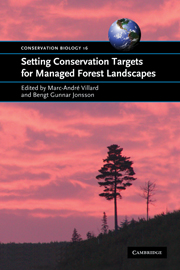Book contents
- Frontmatter
- Contents
- List of contributors
- Foreword
- Acknowledgements
- 1 A plea for quantitative targets in biodiversity conservation
- 2 Setting conservation targets: past and present approaches
- 3 Designing studies to develop conservation targets: a review of the challenges
- 4 Testing the efficiency of global-scale conservation planning by using data on Andean amphibians
- 5 Selecting biodiversity indicators to set conservation targets: species, structures, or processes?
- 6 Selecting species to be used as tools in the development of forest conservation targets
- 7 Bridging ecosystem and multiple species approaches for setting conservation targets in managed boreal landscapes
- 8 Thresholds, incidence functions, and species-specific cues: responses of woodland birds to landscape structure in south-eastern Australia
- 9 Landscape thresholds in species occurrence as quantitative targets in forest management: generality in space and time?
- 10 The temporal and spatial challenges of target setting for dynamic habitats: the case of dead wood and saproxylic species in boreal forests
- 11 Opportunities and constraints of using understory plants to set forest restoration and conservation priorities
- 12 Setting conservation targets for freshwater ecosystems in forested catchments
- 13 Setting quantitative targets for recovery of threatened species
- 14 Allocation of conservation efforts over the landscape: the TRIAD approach
- 15 Forest landscape modeling as a tool to develop conservation targets
- 16 Setting targets: tradeoffs between ecology and economics
- 17 Setting, implementing, and monitoring targets as a basis for adaptive management: a Canadian forestry case study
- 18 Putting conservation target science to work
- Index
- References
16 - Setting targets: tradeoffs between ecology and economics
Published online by Cambridge University Press: 05 June 2012
- Frontmatter
- Contents
- List of contributors
- Foreword
- Acknowledgements
- 1 A plea for quantitative targets in biodiversity conservation
- 2 Setting conservation targets: past and present approaches
- 3 Designing studies to develop conservation targets: a review of the challenges
- 4 Testing the efficiency of global-scale conservation planning by using data on Andean amphibians
- 5 Selecting biodiversity indicators to set conservation targets: species, structures, or processes?
- 6 Selecting species to be used as tools in the development of forest conservation targets
- 7 Bridging ecosystem and multiple species approaches for setting conservation targets in managed boreal landscapes
- 8 Thresholds, incidence functions, and species-specific cues: responses of woodland birds to landscape structure in south-eastern Australia
- 9 Landscape thresholds in species occurrence as quantitative targets in forest management: generality in space and time?
- 10 The temporal and spatial challenges of target setting for dynamic habitats: the case of dead wood and saproxylic species in boreal forests
- 11 Opportunities and constraints of using understory plants to set forest restoration and conservation priorities
- 12 Setting conservation targets for freshwater ecosystems in forested catchments
- 13 Setting quantitative targets for recovery of threatened species
- 14 Allocation of conservation efforts over the landscape: the TRIAD approach
- 15 Forest landscape modeling as a tool to develop conservation targets
- 16 Setting targets: tradeoffs between ecology and economics
- 17 Setting, implementing, and monitoring targets as a basis for adaptive management: a Canadian forestry case study
- 18 Putting conservation target science to work
- Index
- References
Summary
INTRODUCTION
Habitat loss is the main threat to biodiversity. Conversion of land to urban sprawl and agricultural land is widespread, particularly in southern temperate regions. In the boreal forest zone, landscapes have remained primarily forested while undergoing spatial and temporal changes in composition and age structure. Within the seemingly intact forest cover, habitat degradation has resulted in habitat loss for many species. Common to these types of landscape changes is that human activities have resulted in a shortage of area for species and their habitats. Preventing further habitat loss, that is conservation, causes restrictions to other land-use types and often incurs considerable economic costs in terms of foregone opportunities. Therefore, there is an immanent tradeoff between alternative land-use practices. How much trading in ecological values we are willing to accept for increasing economic welfare is an important ethical question, and relates to the discussion of weak versus strong sustainability (Costanza 1996). From a scientific point of view, the tradeoff between ecological and economic targets calls for the development of procedures and methods to cope with it in a balanced way.
The tradeoff between ecological and economic targets reflects land-use demands. Market value of land varies widely across sites according to, for example, location, potential other uses, and primary productivity. Pressures to develop a parcel of land increase in proximity to dense human populations, yet social benefits from undeveloped land (e.g. recreation and conservation) also increase with proximity. Therefore, land value tends to decrease with distance from cities.
- Type
- Chapter
- Information
- Setting Conservation Targets for Managed Forest Landscapes , pp. 328 - 351Publisher: Cambridge University PressPrint publication year: 2009
References
- 1
- Cited by

